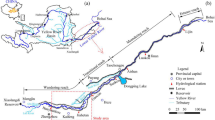Abstract
The Xiaolangdi Hydro-Project is one of the large projects on the main stem of the Middle Yellow River. It has been operated for more than 10 years, since its impoundment in October, 1999. The reservoir has trapped 2.833×109 m3 of sediment, and caused the total erosion of 1.891×109 t in the Lower Yellow River from October, 1999 through October, 2010. Not only the serious atrophied situation of the Lower Yellow River (LYR) has been resuscitating, but also many new phenomena of sediment transport and behaviors of channel re-establishing are coming into being. They are illustrated and discussed in detail in this paper.
Similar content being viewed by others
References
PAN Xian-di, LI Yong and ZHANG Xiao-hua et al. The fluvial processes in the Lower Yellow River after completion of Sanmenxia Reservoir[M]. Zhengzhou: The Yellow River Press, 2006(in Chinese).
MINISTRY OF WATER RESOURCES. Sediment communique of chinese rivers[M]. Beijing: China Water Resources and Hydropower Press, 2010(in 924 Chinese).
SUI J., PETER J. and LIU C. et al. Characteristics of sediment transport along a river reach with a reservoir[J]. International Journal of Sediment Research, 2005, 20(2): 89–101.
MA Huai-bao, ZhANG Jun-hua and CHEN Shu-kui et al. Analyses on patterns of deposition since operation of Xiaolangdi Reservoir[J]. Journal of the Yellow River, 2011, 33(11): 16–17(in Chinese).
ZHAO Qin, LI Jia and AN Rui-dong. Two-phase flow models for turbid density current in a reservoir[J]. Chinese Journal of Hydrodynamics, 2010, 25(1): 76–84(in Chinese).
PAKER G., TONIOLO H. Note on the analysis of plunging reservoir flows[J]. Journal of Hydraulic Engineering, ASCE, 2007, 133(6): 690–694.
De CESARE G., SCHLEISS A. and HERMANN F. Impact of turbidity currents on reservoir sedimentation[J]. Journal of Hydraulic Engineering, ASCE, 2001, 127(1): 6–16.
ZHANG Hong-wu, ZHANG Jun-hua and ZHONG Deyu et al. Regulation strategies for wandering reaches of Lower Yellow River[J]. Journal of Hydraulic Engineering, 2011,42(1): 5–7(in Chinese).
CHEN Jian-guo, ZHOU Wen-hao and DENG An-jun. Channel shrinkage and its unstability in the Lower Yellow River[J]. International Journal of Sediment Research, 2006, 21(1): 13–23.
CHEN Jian-guo, ZHOU Wen-hao and CHEN Qiang. Channel re-establishment of the Lower Yellow River in ten years operation of Xiaolangdi Reservoir[J]. Journal of Hydraulic Engineering, 2012, 43(2):127-135(in Chinese).
ZHANG Jun-hua, ZHANG Hong-wu and JIANG Chang-bo et al. Mathematical model of river bed change downstream of Xiaolangdi Reservoir[J]. Journal of Hydrodynamics, Ser. A, 2002, 14(1): 106–112(in Chinese).
CHEN Jian-guo, ZHOU Wen-hao and SUN Ping. Effects of water-sediment regulation by Xiaolangdi Reservoir on channel erosion in the Lower Yellow River[J]. Journal of Sediment Research, 2009, (3): 1–7(in Chinese).
WU Teng, ZHANG Hong-wu. Adaptive operation method for reservoir in sediment-laden rivers[J]. Journal of Hydraulic Engineering, 2009, 40(2): 17–19(in chinese).
ZHANG Hong-wu, HUANG Yu-jie. Mathematical model of river bed change downstream of Xiaolangdi Reservoir in early operation period[J]. Journal of Hydroelectric Engineering, 2002, (S1): 139–145(in Chinese).
FANG Hong-wei, WANG Guang-qian. Depth-averaged 2-D numerical simulation for total sediment transport and its application[J]. Journal of Basic Science and Engineering, 2000, 8(2): 165–178(in Chinese).
HAN Dong, FANG Hong-wei. A study of sediment transport modele in one-dimensional numerical channel network model[J]. Chinese Journal of Theoretical and Applied Mechanics, 2011, 43(1): 476–481(in Chinese).
CHEN Jian-guo, ZHOU Wen-hao and CHEN Qiang. Key problems needed to be studied for further regulation of water and sediment of the XLD Reservoir[J]. China Water Resources, 2010, (16): 22–25(in Chinese).
Author information
Authors and Affiliations
Corresponding author
Additional information
Project supported by the National Basic Research and Development Program of China (973 Program, Grant No. 2011CB409901), the “12th Five-Year Plan” to Support Science and Technology Project (Grant No. 2012BAB02B01) and the Special Funds for Public Welfare Project (Grant No. 200901014).
Biography: CHEN Jian-guo (1962-), Male, Master, Professor
Rights and permissions
About this article
Cite this article
Chen, Jg., Zhou, Wh. & Chen, Q. Reservoir Sedimentation and Transformation of Morpho-Logy in the Lower Yellow River during 10 Year’s Initial Operation of the Xiaolangdi Reservoir. J Hydrodyn 24, 914–924 (2012). https://doi.org/10.1016/S1001-6058(11)60319-3
Received:
Revised:
Published:
Issue Date:
DOI: https://doi.org/10.1016/S1001-6058(11)60319-3



